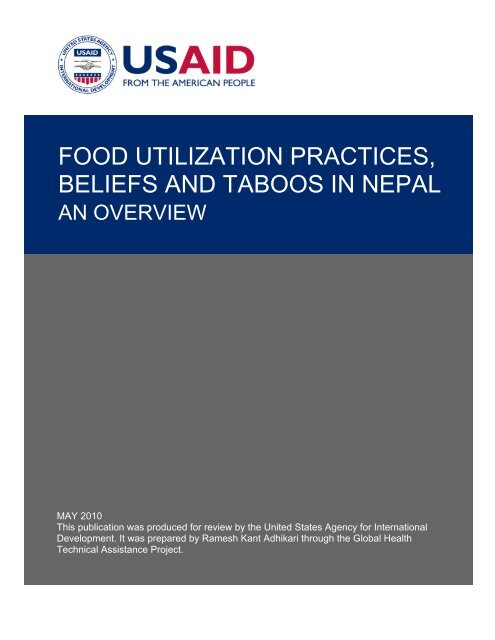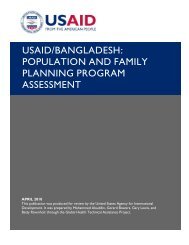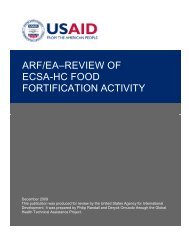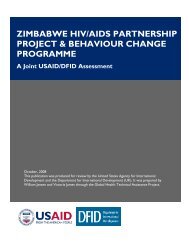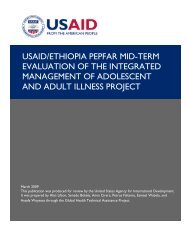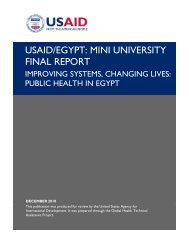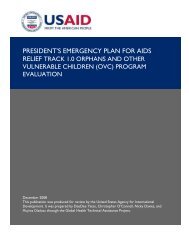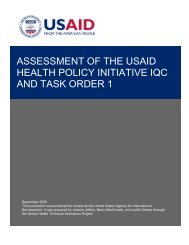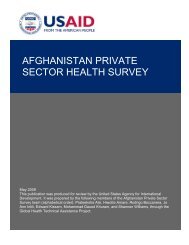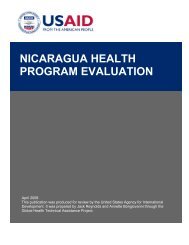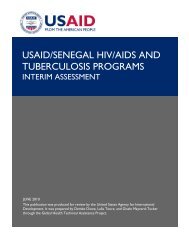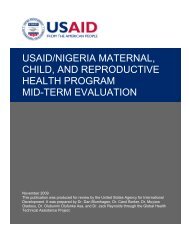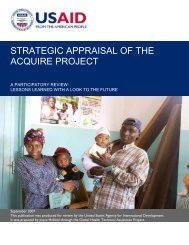Food utilization practices, beliefs and taboos in Nepal: An overview
Food utilization practices, beliefs and taboos in Nepal: An overview
Food utilization practices, beliefs and taboos in Nepal: An overview
- No tags were found...
You also want an ePaper? Increase the reach of your titles
YUMPU automatically turns print PDFs into web optimized ePapers that Google loves.
FOOD UTILIZATION PRACTICES,BELIEFS AND TABOOS IN NEPALAN OVERVIEWMAY 2010This publication was produced for review by the United States Agency for InternationalDevelopment. It was prepared by Ramesh Kant Adhikari through the Global HealthTechnical Assistance Project.
FOOD UTILIZATION PRACTICES,BELIEFS AND TABOOS IN NEPALAN OVERVIEWDISCLAIMERThe authors’ views expressed <strong>in</strong> this publication do not necessarily reflect the viewsof the United States Agency for International Development or the United StatesGovernment.
This document (Report No. 10-01-367) is available <strong>in</strong> pr<strong>in</strong>t or onl<strong>in</strong>e. Onl<strong>in</strong>e documents can belocated <strong>in</strong> the GH Tech website library at www.ghtechproject.com/resources\. Documents arealso available through the Development Experience Clear<strong>in</strong>ghouse (www.dec.org). Additional<strong>in</strong>formation can be obta<strong>in</strong>ed from:The Global Health Technical Assistance Project1250 Eye St., NW, Suite 1100Wash<strong>in</strong>gton, DC 20005Tel: (202) 521-1900Fax: (202) 521-1901<strong>in</strong>fo@ghtechproject.comThis document was submitted by The QED Group, LLC, with CAMRIS International <strong>and</strong> Social& Scientific Systems, Inc., to the United States Agency for International Development underUSAID Contract No. GHS-I-00-05-00005-00.
CONTENTSACRONYMS ..................................................................................................................... iiiINTRODUCTION ............................................................................................................... 1METHODOLOGY .............................................................................................................. 3TOPIC AREAS .................................................................................................................. 5<strong>Food</strong> Production ...................................................................................................................... 5<strong>Food</strong> Consumption Patterns ................................................................................................... 6Caloric Intake of the Population .............................................................................................. 7Intra-Household <strong>Food</strong> Distribution .......................................................................................... 8<strong>Food</strong> Beliefs .......................................................................................................................... 10<strong>Food</strong> Practices of Mothers <strong>and</strong> IYCF Practices .................................................................... 10Undernutrition — Beliefs, Practices <strong>and</strong> Treatment .............................................................. 13QUANTITATIVE INFORMATION ON SELECTED CHILD AND MATERNALFEEDING PRACTICES ................................................................................................... 15Breast-feed<strong>in</strong>g ....................................................................................................................... 15Pre-lacteal Feeds .................................................................................................................. 15Duration <strong>and</strong> Frequency of Breast-feed<strong>in</strong>g ........................................................................... 15Breast-feed<strong>in</strong>g Status at Different Ages ............................................................................... 15Types of Complementary <strong>Food</strong> ............................................................................................ 16Complementary Feed<strong>in</strong>g of Infants <strong>and</strong> Young Children ..................................................... 16<strong>Food</strong>s Consumed by Mothers ............................................................................................... 16Vitam<strong>in</strong> A Intake Among Children ......................................................................................... 16Iron Intake Among Children .................................................................................................. 17Vitam<strong>in</strong> A Intake Among Mothers ......................................................................................... 17Iron Intake Among Mothers .................................................................................................. 17IMPLICATION OF THESE FINDINGS FOR NUTRITION PROGRAM ........................... 19<strong>Food</strong> Production <strong>and</strong> Availability .......................................................................................... 19Calorie Intake ........................................................................................................................ 19Intra-Household <strong>Food</strong> Distribution ........................................................................................ 19Child Plate Shar<strong>in</strong>g with Adults ............................................................................................. 19Breast-feed<strong>in</strong>g ....................................................................................................................... 19Maternal Nutrition Dur<strong>in</strong>g Pregnancy.................................................................................... 20Maternal Nutrition Dur<strong>in</strong>g Lactation ...................................................................................... 20Recognition of Undernutrition <strong>and</strong> Its Causes ...................................................................... 20Feed<strong>in</strong>g Dur<strong>in</strong>g Childhood Illnesses ..................................................................................... 20Other Resources ............................................................................................................. 21FOOD UTILIZATION PRACTICES, BELIEFS AND TABOOS IN NEPAL: AN OVERVIEWi
iiFOOD UTILIZATION PRACTICES, BELIEFS AND TABOOS IN NEPAL: AN OVERVIEW
ACRONYMSACC/SCNCBSC-IMCIFCHVGoNIYCFMoACMoHPMTNAGANDHSNLSSNFCNPCSORSSLCUNICEFUSAIDWFPWHO(United Nations) Adm<strong>in</strong>istrative Coord<strong>in</strong>at<strong>in</strong>g Committee/Sub-Committeeon NutritionCentral Bureau of StatisticsCommunity Integrated Management of Childhood IllnessesFemale community health volunteersGovernment of <strong>Nepal</strong>Infant <strong>and</strong> young child feed<strong>in</strong>gM<strong>in</strong>istry of Agriculture <strong>and</strong> CooperativesM<strong>in</strong>istry of Health <strong>and</strong> PopulationMetric tonsNational Assessment <strong>and</strong> Gap <strong>An</strong>alysis<strong>Nepal</strong> Demographic Health SurveyNational Life St<strong>and</strong>ard Survey<strong>Nepal</strong> <strong>Food</strong> CorporationNutrition Promotion <strong>and</strong> Consultancy ServicesOral rehydration solutionSchool Level CertificateUnited Nations Children’s FundUnited States Agency for International Development(United Nations) World <strong>Food</strong> ProgramWorld Health OrganizationFOOD UTILIZATION PRACTICES, BELIEFS AND TABOOS IN NEPAL: AN OVERVIEWiii
ivFOOD UTILIZATION PRACTICES, BELIEFS AND TABOOS IN NEPAL: AN OVERVIEW
INTRODUCTION<strong>Nepal</strong>, though a small country <strong>in</strong> comparison to its neighbors Ch<strong>in</strong>a <strong>and</strong> India, is populated bymore than 100 ethnic groups speak<strong>in</strong>g almost the same number of languages. Though the countryis conf<strong>in</strong>ed with<strong>in</strong> an area of 141,000 square kilometers, it has one of the most difficult terra<strong>in</strong>s<strong>and</strong> varied climates rang<strong>in</strong>g from almost tropical <strong>in</strong> the southern pla<strong>in</strong>s to arctic <strong>in</strong> the HimalayanMounta<strong>in</strong>s. These factors have led to an evolv<strong>in</strong>g diversity of habits, <strong>practices</strong>, <strong>and</strong> <strong>beliefs</strong> aroundfood <strong>and</strong> nutrition that have affected health <strong>and</strong> nutrition <strong>in</strong> both positive <strong>and</strong> negative ways. This<strong>overview</strong> will look at some of these differ<strong>in</strong>g <strong>practices</strong> to better underst<strong>and</strong> their importance whenwork<strong>in</strong>g on food <strong>and</strong> nutrition <strong>in</strong> <strong>Nepal</strong>.S<strong>in</strong>ce 1975, many surveys have been conducted that exam<strong>in</strong>e the nutritional status of children <strong>and</strong>women <strong>in</strong> <strong>Nepal</strong>. All of them found a very high prevalence of undernutrition <strong>and</strong> nutritionaldisorders. National Nutrition Strategies, developed <strong>in</strong> 1978 <strong>and</strong> 1986, had focused on improvedagricultural productivity to improve the availability of food. However, subsequent governmentnutrition plans identified the need for improved food <strong>utilization</strong> with<strong>in</strong> households to improvenutritional status. <strong>An</strong> attempt to develop a National Plan of Action <strong>in</strong> 2007 identified householdfood security, child care <strong>practices</strong>, women’s status, <strong>and</strong> responsive health services as the keydeterm<strong>in</strong>ants of childhood nutrition. The most recent effort has been to conduct a NutritionAssessment <strong>and</strong> Gap <strong>An</strong>alysis (NAGA), a jo<strong>in</strong>t effort of the M<strong>in</strong>istry of Health <strong>and</strong> Population(MoHP) <strong>and</strong> donors, <strong>in</strong>clud<strong>in</strong>g United States Agency for International Development (USAID).One f<strong>in</strong>d<strong>in</strong>g <strong>in</strong> this assessment was the gap <strong>in</strong> knowledge about various food behaviors, <strong>in</strong>clud<strong>in</strong>g<strong>in</strong>tra-household food use, diversity of diet, food quality <strong>and</strong> quantity, breast-feed<strong>in</strong>g, <strong>and</strong>complementary feed<strong>in</strong>g <strong>practices</strong>—as well as food h<strong>and</strong>l<strong>in</strong>g, hygiene <strong>practices</strong>, <strong>and</strong> emergencypreparedness <strong>and</strong> their impact on nutritional status.In an effort to contribute to the knowledge about food <strong>beliefs</strong> <strong>and</strong> <strong>practices</strong>, this assessment canbe considered a resource for a better underst<strong>and</strong><strong>in</strong>g of how <strong>beliefs</strong> <strong>and</strong> <strong>practices</strong> affect nutrition <strong>in</strong>communities <strong>and</strong> <strong>Nepal</strong>. Available literature on some of the identified topic areas is <strong>in</strong>cluded <strong>in</strong>each section with a brief summary. This assessment is by no means an exhaustive analysis ofbehaviors <strong>and</strong> culture <strong>in</strong> <strong>Nepal</strong>; rather it provides a glimpse <strong>in</strong>to the rich diversity <strong>in</strong> <strong>Nepal</strong>eseculture as well as its contribution to the nutritional status of women <strong>and</strong> children.FOOD UTILIZATION PRACTICES, BELIEFS AND TABOOS IN NEPAL: AN OVERVIEW 1
2 FOOD UTILIZATION PRACTICES, BELIEFS AND TABOOS IN NEPAL: AN OVERVIEW
METHODOLOGYThe team reviewed a number of exist<strong>in</strong>g documents, start<strong>in</strong>g from the recently completed NAGA.Additional materials reviewed <strong>in</strong>cluded the National Demographic <strong>and</strong> Health Surveys (NDHS),basel<strong>in</strong>e <strong>and</strong> end-l<strong>in</strong>e surveys carried out by different organizations dur<strong>in</strong>g the course of theirwork <strong>and</strong> some publications from academic <strong>and</strong> research <strong>in</strong>stitutions. A review of the literatureon <strong>practices</strong> <strong>and</strong> <strong>beliefs</strong> regard<strong>in</strong>g maternal <strong>and</strong> <strong>in</strong>fant/child nutrition <strong>in</strong> <strong>Nepal</strong>, with fund<strong>in</strong>g fromUSAID <strong>in</strong> 1998, was also referred to wherever relevant.FOOD UTILIZATION PRACTICES, BELIEFS AND TABOOS IN NEPAL: AN OVERVIEW 3
4 FOOD UTILIZATION PRACTICES, BELIEFS AND TABOOS IN NEPAL: AN OVERVIEW
TOPIC AREASIn order to consolidate the variety of <strong>practices</strong> <strong>and</strong> <strong>beliefs</strong> that affect nutrition, the follow<strong>in</strong>gtopics of relevance to maternal <strong>and</strong> childhood nutrition have been reviewed:<strong>Food</strong> Production: The type <strong>and</strong> quantity of foods produced determ<strong>in</strong>e the food <strong>practices</strong> ofthe population. It is also important because it has direct relevance to availability of food <strong>and</strong>household food security.<strong>Food</strong> Consumption Patterns: The typical eat<strong>in</strong>g pattern of a <strong>Nepal</strong>i household helps tounderst<strong>and</strong> the tim<strong>in</strong>g <strong>and</strong> frequency of eat<strong>in</strong>g as well as the types of food eaten throughoutthe day.Caloric Intake of the Population: The current estimates of calorie <strong>in</strong>take <strong>and</strong> theirdeterm<strong>in</strong>ants will help to underst<strong>and</strong> the basic degree of <strong>in</strong>adequacy of nutrition.Intra-Household <strong>Food</strong> Distribution: It is important to underst<strong>and</strong> the <strong>practices</strong> of fooddistribution among different family members. Some communities are more egalitarian thanothers when shar<strong>in</strong>g food. How food is distributed among different family members<strong>in</strong>fluences the <strong>in</strong>take <strong>and</strong> thus the nutritional status of its members.<strong>Food</strong> Beliefs: The value accorded to a food item varies accord<strong>in</strong>g to the food <strong>beliefs</strong> <strong>and</strong>other cultural factors. The cultural <strong>beliefs</strong> will determ<strong>in</strong>e whether or not a food is consumeddespite its availability.<strong>Food</strong> Practices of Mothers <strong>and</strong> Infant <strong>and</strong> Young Child Feed<strong>in</strong>g (IYCF) Practices,Includ<strong>in</strong>g Dur<strong>in</strong>g Childhood Illnesses: Feed<strong>in</strong>g <strong>practices</strong> dur<strong>in</strong>g pregnancy <strong>and</strong> lactationdeterm<strong>in</strong>e the nutritional status of mothers <strong>and</strong> their children.Undernutrition – Beliefs, Practices, <strong>and</strong> Treatment: In many communities where a majorityof the children are stunted, undernutrition may not be visible. Underst<strong>and</strong><strong>in</strong>g perceptionsabout different grades of undernutrition will help to develop strategic responses to theseissues.FOOD PRODUCTIONRice, wheat, maize, millet, <strong>and</strong> barley are the major cereal crops produced <strong>in</strong> <strong>Nepal</strong>. Accord<strong>in</strong>g tothe M<strong>in</strong>istry of Agriculture <strong>and</strong> Cooperatives (MoAC) press release on May 13, 2010, paddy,maize, wheat, millet <strong>and</strong> barley contribute 45%, 26%, 24%, 5%, <strong>and</strong> 1%, respectively, of the totalgra<strong>in</strong> production 1 . In areas with irrigated pla<strong>in</strong>s <strong>and</strong> terraced fields, such as <strong>in</strong> the Terai <strong>and</strong> Hillvalleys, ma<strong>in</strong>ly rice <strong>and</strong> wheat are produced; whereas hills with dry l<strong>and</strong> produce primarily maize<strong>and</strong> millet. In the fields of the high mounta<strong>in</strong>s, the major crops <strong>in</strong>clude potatoes, millets, <strong>and</strong>barley.The other crops of importance produced <strong>in</strong> <strong>Nepal</strong> are sugarcane, oilseeds, potatoes, <strong>and</strong> pulses.Districts <strong>in</strong> Terai produce the largest amount of these cash crops. As for other food items, such asmilk <strong>and</strong> dairy products, livestock, <strong>and</strong> poultry, though show<strong>in</strong>g a gradual <strong>in</strong>crease <strong>in</strong> recentyears, are a relatively smaller proportion of the total food production <strong>and</strong> thus a smaller part ofthe diet of the people.1 ―Gra<strong>in</strong> output drops by 4.33%.‖ The Kathm<strong>and</strong>u Post, May 13, 2010.FOOD UTILIZATION PRACTICES, BELIEFS AND TABOOS IN NEPAL: AN OVERVIEW 5
Until 1980, <strong>Nepal</strong> was a food-sufficient country. S<strong>in</strong>ce then the population growth rate hassurpassed the growth <strong>in</strong> food production <strong>and</strong> <strong>Nepal</strong> has had to import food to feed its population.The Central Bureau of Statistics (CBS) statistics reported a surplus of cereal gra<strong>in</strong> until FY 2003-2004. 2 However, conditions have gradually deteriorated <strong>and</strong> the latest estimates of the MoACpredict a 4.33% shortfall <strong>in</strong> gra<strong>in</strong> production <strong>in</strong> FY 2009–2010. The overall gra<strong>in</strong> output was 8.1million tons last year <strong>and</strong> dropped to 7.6 million metric tons this year. Given the <strong>in</strong>creas<strong>in</strong>gpopulation <strong>and</strong> production ratio, there is likely to be a shortfall of 316,465 metric tons (MT) <strong>in</strong>food availability this year compared to last year. The estimated food deficit was 132,914 MT.Accord<strong>in</strong>g to MoAC estimates, 1.6 million people will face food unavailability this year. The Mid<strong>and</strong> Far Western regions will be most affected by food scarcity. 3In <strong>Nepal</strong>, nutritional <strong>in</strong>dicators do not directly correlate with agricultural production. Forexample, though the Terai region has the highest production of staple crops <strong>and</strong> has the smallestnumber <strong>in</strong> the lowest wealth category, its undernutrition rates are among the highest <strong>in</strong> thecountry. In 2006, the Central Terai showed wast<strong>in</strong>g (a severe form of undernutrition) <strong>in</strong> 20.7% ofchildren, compared to only 6.1% <strong>in</strong> the Central Mounta<strong>in</strong>s. 4 These statistics re<strong>in</strong>force the po<strong>in</strong>tthat the pure availability of food <strong>in</strong> <strong>Nepal</strong> does not necessarily provide any guarantee aga<strong>in</strong>stundernutrition. In order to improve the nutritional status, both availability of foods <strong>and</strong> better<strong>utilization</strong> through proper distribution <strong>and</strong> consumption among women <strong>and</strong> children needs to beprioritized.FOOD CONSUMPTION PATTERNSBased on the pattern of food production, it is clear that the major staples of the <strong>Nepal</strong>i population<strong>in</strong>clude rice <strong>and</strong> wheat <strong>in</strong> the Terai; maize <strong>and</strong> millets <strong>in</strong> the hills; <strong>and</strong> millet, maize, <strong>and</strong> barley <strong>in</strong>the mounta<strong>in</strong>s. Potatoes are also an important part of the diet <strong>in</strong> the mounta<strong>in</strong>s. However, <strong>in</strong>recent years, more food has been imported from outside, result<strong>in</strong>g <strong>in</strong> changes <strong>in</strong> food habits of thepeople liv<strong>in</strong>g <strong>in</strong> the remote hills <strong>and</strong> mounta<strong>in</strong> districts. In addition, the Government of <strong>Nepal</strong>(GoN) has been transport<strong>in</strong>g rice <strong>and</strong> other food items to remote mounta<strong>in</strong> districts s<strong>in</strong>ce theestablishment of <strong>Nepal</strong> <strong>Food</strong> Corporation (NFC) <strong>in</strong>1974, 5 lead<strong>in</strong>g to an <strong>in</strong>crease <strong>in</strong> riceconsumption <strong>in</strong> those districts.The typical practice <strong>in</strong> <strong>Nepal</strong>i households is to have two meals a day with a snack <strong>in</strong> theafternoon. The mid-morn<strong>in</strong>g meals eaten around 9 to 10 a.m. consist of rice or wheat bread ormaize bread, or porridge with lentils <strong>and</strong> vegetables <strong>in</strong> relatively affluent houses. Those whocannot afford lentils or vegetables eat only one of the items. Roasted maize, beans or wheat, ormillet bread constitute the snacks. Those who can afford to keep cattle consume small amounts ofmilk or buttermilk with their meals. Consum<strong>in</strong>g vegetables is a common practice <strong>and</strong> it isgradually <strong>in</strong>creas<strong>in</strong>g <strong>in</strong> some areas. Some communities raise goats, chickens <strong>and</strong> pigs; however,eat<strong>in</strong>g meat even <strong>in</strong> a relatively well-off family is rare, happen<strong>in</strong>g on a weekly basis whenpossible.Because of their religious <strong>beliefs</strong>, some communities <strong>and</strong> ethnic groups do not eat chicken eggs,chicken, pigs, or buffaloes. For example, Terje Oestgaard, 6 <strong>in</strong> his study among Brahmans <strong>and</strong>2 Government of <strong>Nepal</strong>/National Plann<strong>in</strong>g Commission/Central Bureau of Statistics. Statistical PocketBook. <strong>Nepal</strong> 2006.3 ―Gra<strong>in</strong> output drops by 4.33%.‖ The Kathm<strong>and</strong>u Post, May 13, 2010.4 GoN/MoHP/New Era/Macro International, USA. <strong>Nepal</strong> Demographic <strong>and</strong> Health Survey 2006.Kathm<strong>and</strong>u, <strong>Nepal</strong>.5 Website of <strong>Nepal</strong> <strong>Food</strong> Corporation, www.nfc.org.np6 Oestgaard, T. <strong>Food</strong> rituals <strong>and</strong> Taboos: <strong>An</strong> Ethno archeological study among Brahmans <strong>and</strong> Magars ofBaglung District, <strong>Nepal</strong>.6 FOOD UTILIZATION PRACTICES, BELIEFS AND TABOOS IN NEPAL: AN OVERVIEW
Magars, observed that though both communities kept buffaloes, Brahmans used them only fortheir secondary products whereas Magars ate their meat as well. Magars, who did not raise pigsbecause they considered them messy, did <strong>in</strong> fact consume pork.<strong>An</strong>other example taken from the hills is presented by Gallagher, 7 who reported about the life <strong>in</strong> aGurung village <strong>in</strong> Gorkha district <strong>in</strong> 1987. This report described the food <strong>and</strong> agricultural<strong>practices</strong> <strong>in</strong> that community. The report may not be considered a description applicable to all theGurungs <strong>in</strong> <strong>Nepal</strong>, yet it gives a good <strong>in</strong>sight <strong>in</strong>to the food <strong>practices</strong> <strong>in</strong> a particular Hillcommunity. Gallagher writes:―On ris<strong>in</strong>g, the villagers eat a snack of roasted pulses <strong>and</strong> or popped corn. They thendepart to gather the first grass of the day for the animals. The women return <strong>in</strong> time tocook the morn<strong>in</strong>g rice meal, which will be eaten any time between 9-11 a.m. The usualgra<strong>in</strong> eaten is corn although millet is widely eaten. Both gra<strong>in</strong>s are ground on the stonegr<strong>in</strong>dstone <strong>and</strong> made <strong>in</strong>to coarse flour which is then cooked up to a thick porridge. Thisflour can also be made <strong>in</strong>to breads. Although the rice is the gra<strong>in</strong> of preference it is noteaten daily by the majority of people. The prote<strong>in</strong> source is usually black gram or soyabeans cooked with spices. If a vegetable is available, this will also be eaten with the gra<strong>in</strong><strong>and</strong> or green leafy vegetables. If this is not available, the villagers may just eat the ma<strong>in</strong>gra<strong>in</strong> flavoured with turmeric along with a prote<strong>in</strong> source. The majority of people dr<strong>in</strong>keither water, homemade beer or their own distilled alcohol. A considerable amount of themillet grown <strong>and</strong> a certa<strong>in</strong> amount of the corn is used by the villagers not as a food, butto make this beer or alcohol. The concentrated beer can be eaten thick as a snack, oftenthis is the way older children eat it or water can be added to make a thick soup like dr<strong>in</strong>k.The analysis of the concentrated beer showed rather a higher alcohol content than hadbeen expected <strong>and</strong> as this beer is given to children, this could have serious implications.”These few examples show that there is a diverse set of food consumption patterns depend<strong>in</strong>g onthe region, caste, <strong>and</strong> food availability. Furthermore, the use of available products is also veryimportant to underst<strong>and</strong> <strong>and</strong> could be potentially harmful to a child, for example millet <strong>and</strong> cornbasedalcohol <strong>in</strong> the Hills. Therefore, programs aimed at improv<strong>in</strong>g the nutritional status ofwomen <strong>and</strong> children will have to consider these diverse consumption patterns <strong>in</strong> order to <strong>in</strong>formrecommendations on diets depend<strong>in</strong>g on the place <strong>and</strong> population.CALORIC INTAKE OF THE POPULATIONA significant proportion of the <strong>Nepal</strong>ese population consume less than adequate calories asreported by CBS on the basis of National Life St<strong>and</strong>ard Survey (NLSS) 2003-2004 <strong>and</strong> SmallArea Estimation of Poverty. 8 The prevalence of <strong>in</strong>adequate caloric <strong>in</strong>take varies from 35.2% to39.8% of the adult population <strong>in</strong> <strong>Nepal</strong>. The calorie requirement was estimated at 2709 Kcals/dayrequired susta<strong>in</strong><strong>in</strong>g moderate activity. The estimates were calculated on the basis of reportedexpenditure on food. The prevalence of <strong>in</strong>adequate caloric <strong>in</strong>take levels is highest for the regionswith the lowest food production: Midwestern <strong>and</strong> Far Western regions have a prevalence of<strong>in</strong>adequate caloric <strong>in</strong>take higher by 7% to 8% compared to the national averages.There is no relationship between food availability <strong>and</strong> calorie <strong>in</strong>take <strong>in</strong> urban areas: availability ishigher than <strong>in</strong> many rural areas, yet the prevalence of <strong>in</strong>adequate caloric <strong>in</strong>take was found to bethe highest for urban Kathm<strong>and</strong>u. This could be due to the methodology used, which calculates7 Gallagher, C. M. <strong>An</strong> <strong>overview</strong> of life <strong>in</strong> a Gurung Village <strong>in</strong> Gorkha district. 1987.8 GoN/NPC/CBS/WFP. Small Area Estimation of Poverty, Caloric Intake <strong>and</strong> Malnutrition <strong>in</strong> <strong>Nepal</strong>.Kathm<strong>and</strong>u, <strong>Nepal</strong>, 2006.FOOD UTILIZATION PRACTICES, BELIEFS AND TABOOS IN NEPAL: AN OVERVIEW 7
calorie <strong>in</strong>take on the basis of amount of money spent to buy food. The NLSS 2003-2004 alsofound that the people <strong>in</strong> the wealthiest category spent almost double the amount of money per1000 kcal (Rs. 5.5 vs. Rs.11.4 per 1000 kcal). This observation calls for programs to <strong>in</strong>cludeeducational approaches to improve budget management for food expenditures. Aside from thisstudy, a number of more rigorous researches also have also shown <strong>in</strong>adequate calorieconsumption prevalent among the <strong>Nepal</strong>ese people.Except for one study, 9 which had reported higher than required calorie <strong>in</strong>take by adolescents <strong>in</strong>two of three study sites, most of the studies confirm the assumption that the calorie <strong>in</strong>take amonga significant proportion of <strong>Nepal</strong>ese population is <strong>in</strong>adequate.A study conducted <strong>in</strong> the Southeastern part (Terai district) of <strong>Nepal</strong> among those attend<strong>in</strong>gimmunization services for JE vacc<strong>in</strong>e 10 found that the usual daily diet <strong>in</strong> the research areaconsisted of morn<strong>in</strong>g tea with milk <strong>and</strong> two meals a day: primarily of boiled rice, pulse soup,stew with potato, <strong>and</strong> vegetable <strong>and</strong> salt-pickled vegetable with season<strong>in</strong>gs. The total weight offood consumed per day amounted to 1169 <strong>and</strong> 1044g for males <strong>and</strong> females respectively. About39% of total consumed weight came from cereal, of which rice accounted for about 86%. Ricewas the staple food with a daily mean consumption of 378 <strong>and</strong> 374g for males <strong>and</strong> femalesrespectively. The average energy <strong>in</strong>take was 2427 <strong>and</strong> 2275 calories for males <strong>and</strong> femalesrespectively.<strong>An</strong>other research study 11 which looked at consumption patterns of people liv<strong>in</strong>g <strong>in</strong> Kathm<strong>and</strong>uvalley was conducted <strong>in</strong> 1997. The study of male tempo drivers <strong>and</strong> female carpet weavers, foundthat these groups consumed ma<strong>in</strong>ly rice, potatoes, meats, milk <strong>and</strong> dairy products, <strong>and</strong> vegetables.The researchers found that the amounts of food consumed by both sexes—especially thefemales—were mostly <strong>in</strong>sufficient. Both males <strong>and</strong> females had an energy <strong>in</strong>take lower than thatof estimated requirements <strong>and</strong> than that <strong>in</strong> the Terai region. The reasons for lower <strong>in</strong>take were notprovided <strong>in</strong> this document.<strong>An</strong>other study 12 conducted <strong>in</strong> Nawalparasi, a Western Terai district, looked <strong>in</strong>to the genderdifferences <strong>in</strong> dietary <strong>in</strong>take among adults of a H<strong>in</strong>du community. The average energy <strong>in</strong>take forboth males <strong>and</strong> females was less than adequate (Males: 2068 kcals/day, Females: 1789kcals/day). The food consumed consisted ma<strong>in</strong>ly of rice, potatoes, vegetable curries, <strong>and</strong> dalsoup. Meat <strong>and</strong> fish curries were less frequently consumed, <strong>and</strong> these less frequently consumedfoods were eaten more by males. This study also supported the assumption that the females are ata disadvantage regard<strong>in</strong>g caloric <strong>in</strong>take.INTRA-HOUSEHOLD FOOD DISTRIBUTIONHouseholds’ access to available food is a less important determ<strong>in</strong>ant of nutritional status thanhow food is distributed among members of households, particularly children <strong>and</strong> women. Thereare not many studies report<strong>in</strong>g on this aspect of food <strong>utilization</strong> from <strong>Nepal</strong>. However, theavailable studies po<strong>in</strong>t to a hierarchy exist<strong>in</strong>g <strong>in</strong> the distribution of food with<strong>in</strong> households that is9 Regmi, S. <strong>and</strong> R. Adhikari. A study of factors <strong>in</strong>fluenc<strong>in</strong>g the nutritional status of adolescent girls <strong>in</strong><strong>Nepal</strong>. ICRW, Wash<strong>in</strong>gton DC, May 1994.10 Hirai, K. <strong>and</strong> J. Nayakama. ―<strong>Food</strong> consumption <strong>and</strong> nutrient <strong>in</strong>take <strong>and</strong> their relationship among<strong>Nepal</strong>ese.‖ American Journal of Cl<strong>in</strong>ical Nutrition.1988.11 Ohno, Y. <strong>and</strong> K. Hirai. ―<strong>Food</strong> consumption <strong>and</strong> serum nutritional status of people liv<strong>in</strong>g <strong>in</strong> Kathm<strong>and</strong>u.‖Environmental Health <strong>and</strong> Preventive Medic<strong>in</strong>e, Vol. 10, No. 2. Spr<strong>in</strong>ger Japan, March 2005.12 Sudo, N., M. Sekiyama, M. Maharjan, <strong>and</strong> R. Ohtuska. ―Gender differences <strong>in</strong> dietary <strong>in</strong>take amongadults of H<strong>in</strong>du community <strong>in</strong> lowl<strong>and</strong> <strong>Nepal</strong>: Assessment of portion sizes <strong>and</strong> food consumptionfrequencies,‖ European Journal of Cl<strong>in</strong>ical Nutrition, Vol. 60:469–477, 2006.8 FOOD UTILIZATION PRACTICES, BELIEFS AND TABOOS IN NEPAL: AN OVERVIEW
detrimental to women’s food <strong>in</strong>take. Similarly, children shar<strong>in</strong>g a food plate with a male orfemale member of the family have a different <strong>in</strong>take of micronutrients.Gittelsohn J, 13 exam<strong>in</strong>ed <strong>in</strong>tra-household food behaviors <strong>in</strong> six villages <strong>in</strong> a rural Hill area of MidWestern <strong>Nepal</strong>. Qualitative <strong>and</strong> quantitative methods were used to collect data on food <strong>beliefs</strong>ystems, household allocation of food resources <strong>and</strong> the effects of these features on diet <strong>and</strong>anthropometric status <strong>in</strong> a sample of 767 <strong>in</strong>dividuals <strong>in</strong> 115 households. The results document avariety of mechanisms by which some <strong>in</strong>dividuals are favoured over others through householdfood distribution. This <strong>in</strong>cludes serv<strong>in</strong>g order, serv<strong>in</strong>g method, refus<strong>in</strong>g to serve foods,channel<strong>in</strong>g foods, <strong>and</strong> distribut<strong>in</strong>g low-status food for higher-status foods. No differences wereobserved <strong>in</strong> mechanisms of food distribution or nutrient <strong>in</strong>take between male <strong>and</strong> female children,contrary to the evidence <strong>in</strong> the literature suggest<strong>in</strong>g that male children will be favoured. On theother h<strong>and</strong>, adult women were less likely to meet their nutrient requirement for energy, betacarotene,riboflav<strong>in</strong> <strong>and</strong> vitam<strong>in</strong> C than men of the same age. Women’s late position <strong>in</strong> householdserv<strong>in</strong>g order, channel<strong>in</strong>g of special foods to males <strong>and</strong> children, <strong>and</strong> lower <strong>in</strong>take of foodsaccounts for these f<strong>in</strong>d<strong>in</strong>gs.How a child is served food also seems to <strong>in</strong>fluence the <strong>in</strong>take. A case control study, by ShankarA.V., Gittlesohn J., West Jr., K.P. et al 14 , evaluated the relationship between shared plate eat<strong>in</strong>gbehaviors <strong>in</strong> young <strong>Nepal</strong>i children (aged 1–6 years) <strong>and</strong> the risk of vitam<strong>in</strong> A deficiency. Daylongobservations of dietary <strong>practices</strong> were conducted for seven days over a 15-month period <strong>in</strong>162 households. Eighty-one households with a child with a known history of mildxerophthalmia (cases) were matched with 81 hav<strong>in</strong>g a non-xerophthalmic child of similar age(controls). Shared-plate eat<strong>in</strong>g occurred <strong>in</strong> 25% of all feed<strong>in</strong>g episodes, <strong>and</strong> at least once <strong>in</strong>65% of all days observed. Overall, children engaged <strong>in</strong> shared-plate eat<strong>in</strong>g were significantlymore likely to consume gra<strong>in</strong>s, vegetables, carotenoid-rich vegetables, pulses, fruits, meats <strong>and</strong>fish, <strong>and</strong> dairy products, compared with children who ate alone. In general, feed<strong>in</strong>g behaviorsbetween case <strong>and</strong> control children tended to be similar. However, shared-plate feed<strong>in</strong>g episodesamong case children were significantly less likely to <strong>in</strong>clude meats or fish dairy products orpulses. Individual plate feed<strong>in</strong>g episodes among case children were more likely to <strong>in</strong>cludevegetables than those of control children. Case children were more likely to share a plate with amale adult, but less likely to eat from a plate shared with females of any age compared withcontrols. Shared-plate feed<strong>in</strong>g may benefit a young child’s dietary <strong>in</strong>take, but the identity of thefood sharer may modify this <strong>in</strong>fluence.These two examples show that the amount of food available with<strong>in</strong> one household is no guaranteethat women <strong>and</strong> children will have adequate consumption <strong>and</strong> meet their dietary needs. The lowerposition of women <strong>in</strong> the hierarchy of access to food seems to <strong>in</strong>fluence women’s eat<strong>in</strong>g<strong>practices</strong>. For children, this hierarchy also <strong>in</strong>fluences their <strong>in</strong>take, depend<strong>in</strong>g on the hierarchy ofwhom the food is shared with dur<strong>in</strong>g eat<strong>in</strong>g times.Though these are just few small examples, their implication <strong>in</strong> underst<strong>and</strong><strong>in</strong>g how culture<strong>in</strong>fluences food consumption is critical. Communication strategies aimed at improv<strong>in</strong>g maternal<strong>and</strong> child nutrition will have to show awareness of such realities at the household level.<strong>An</strong>y assessment of food behaviors <strong>in</strong> a program area will have to design tools <strong>and</strong> programs thataddress these <strong>in</strong>equities <strong>in</strong> access to food.13 Gittelsohn, J. ―Open<strong>in</strong>g the box: Intrahousehold food distribution <strong>in</strong> rural <strong>Nepal</strong>.‖ Social Science <strong>and</strong>Medic<strong>in</strong>e, Vol. 33(10): 1141–1154, 1991.14 Shankar, A. V., J. Gittelsohn J., K. P. West Jr., R. Stall<strong>in</strong>gs, T. Gnyawali, <strong>and</strong> F. Faruque. ―Eat<strong>in</strong>g from ashared plate affects food consumption <strong>in</strong> Vitam<strong>in</strong> A deficient <strong>Nepal</strong>i children.‖ The Journal of Nutrition,128(7):1127–1133, 1998.FOOD UTILIZATION PRACTICES, BELIEFS AND TABOOS IN NEPAL: AN OVERVIEW 9
FOOD BELIEFSCulture has a strong impact on the food behavior of people. The food, habits <strong>and</strong><strong>practices</strong> are closely related to the typical behavior of a particular group of peopleor culture. Such behaviour follows codes of conduct <strong>in</strong> relation to food choice,methods of food preparation <strong>and</strong> eat<strong>in</strong>g, number of meals eaten per day, time ofeat<strong>in</strong>g, <strong>and</strong> the size of the portion eaten. 15A focus group discussion about fruit <strong>and</strong> vegetable consumption patterns was carried out byN. Khadka 16 <strong>in</strong> three villages, two <strong>in</strong> the Hills <strong>and</strong> one <strong>in</strong> a Terai village. The villagers at all threesites contend that “no one has to teach them to eat fruit <strong>and</strong> vegetables as they eat them dur<strong>in</strong>gtheir seasons.” Similarly, vegetables were regarded as a part of their meals but were eaten “forthey add taste to meals.”Field observations demonstrate villagers’ <strong>beliefs</strong> <strong>in</strong> superior or <strong>in</strong>ferior foods. Wildly grow<strong>in</strong>gvitam<strong>in</strong> A rich leafy vegetables such as st<strong>in</strong>g<strong>in</strong>g nettles, amaranths, <strong>and</strong> garlic pear are allconsidered <strong>in</strong>ferior foods <strong>and</strong>, when it is suggested that eat<strong>in</strong>g them will provide Vitam<strong>in</strong> A,almost all the students <strong>in</strong> a school reacted negatively. Such foods are considered fit for very poorpeople. Most of the villagers <strong>in</strong> the study area agree with the suggestion that nutrition education isnecessary to help the villagers make proper use of locally <strong>and</strong> wildly available foods with anunderst<strong>and</strong><strong>in</strong>g of their role <strong>in</strong> nutrition. <strong>An</strong> exploratory study 17 based on a literature review <strong>and</strong><strong>in</strong>terview with housewives from rural areas of Kathm<strong>and</strong>u <strong>and</strong> Patan <strong>and</strong> teachers of a women’scollege reported on the food <strong>beliefs</strong> of the people. The study found that the people hold the <strong>beliefs</strong>about pure <strong>and</strong> impure food; hot, cold, <strong>and</strong> neutral foods; beneficial or harmful foods; or curativefoods. However, there was no consensus about the nature of a food items across the differentgroups. Such <strong>beliefs</strong> seem to be carried on apparently without any logic. It is important tounderst<strong>and</strong> these <strong>beliefs</strong> <strong>and</strong> their sources before any advice regard<strong>in</strong>g their use can becommented upon.FOOD PRACTICES OF MOTHERS AND IYCF PRACTICESA large number of studies <strong>and</strong> surveys conducted <strong>in</strong> <strong>Nepal</strong> with a focus on maternal <strong>and</strong> childhealth have collected <strong>in</strong>formation on this aspect of nutrition. A review by J S<strong>in</strong>gh 18 <strong>in</strong> 1998summarized f<strong>in</strong>d<strong>in</strong>gs from such studies up through 1997 as follows:Many believe that pregnancy is a natural condition that does not need any particular attention.<strong>An</strong>y special treatment of mothers tends to be for the protection of the unborn child rather thanfor her own health <strong>and</strong> well be<strong>in</strong>g.One widely held belief is that if a woman eats more dur<strong>in</strong>g pregnancy she will have a biggerbaby which can cause problems dur<strong>in</strong>g labour.<strong>Food</strong>s of animal sources are considered good for pregnant women.15 Barasi, E. <strong>and</strong> R. F. Mottram. Human Nutrition, London, Edward Arnold, 1990.16 Khadka, N. B. ―Culture: A dynamic process of social behaviour,‖ International Journal of Language,Society <strong>and</strong> Culture, 2000.17 Shakya, M. ―Traditional <strong>Food</strong> <strong>and</strong> Health Beliefs,‖ <strong>in</strong> Education for Development, Tribhuvan University,Kathm<strong>and</strong>u, 2006.18 S<strong>in</strong>gh, J. A review of the literature on <strong>practices</strong> <strong>and</strong> <strong>beliefs</strong> regard<strong>in</strong>g maternal <strong>and</strong> <strong>in</strong>fant/child nutrition<strong>in</strong> <strong>Nepal</strong>. Kathm<strong>and</strong>u Academy for Educational Development, June 1998.10 FOOD UTILIZATION PRACTICES, BELIEFS AND TABOOS IN NEPAL: AN OVERVIEW
Social factors also <strong>in</strong>fluence the diet of pregnant women: women <strong>and</strong> girls usually eat aftermale members <strong>and</strong> children have eaten <strong>and</strong> have less access to food from animal sources <strong>and</strong>other special foods.Mothers who have recently delivered a baby are considered impure <strong>and</strong> are not allowed to eatwith other family members until the purification ceremony has been held. In somecommunities, mothers’ food <strong>in</strong>take is limited dur<strong>in</strong>g this period.Women <strong>in</strong> mid <strong>and</strong> far western hill regions practice a system <strong>in</strong> which the recently deliveredwomen are kept <strong>in</strong> the cowshed outside their homes <strong>in</strong> very unhygienic conditions.In some cultures, it is believed that a connection between stomach <strong>and</strong> womb exists <strong>and</strong>womb <strong>and</strong> stomach are rested together by not giv<strong>in</strong>g food to the mothers.Ghee, meat, <strong>and</strong> milk are considered good for new mothers for breast-feed<strong>in</strong>g. However, formothers <strong>in</strong> many families, the diet for lactat<strong>in</strong>g mother is the usual family diet because theycan’t afford different foods.The diet for a lactat<strong>in</strong>g mother is further restricted when her baby is ill.The review also summarized f<strong>in</strong>d<strong>in</strong>gs about <strong>in</strong>fant <strong>and</strong> child feed<strong>in</strong>g <strong>practices</strong> as follows:Almost all babies are breast-fed. Some are exclusively breast-fed for a period beyond therecommended six months of age. Giv<strong>in</strong>g pre-lacteal feeds, not giv<strong>in</strong>g colostrums, prolongedexclusive breast-feed<strong>in</strong>g beyond six months of age, start<strong>in</strong>g complementary feeds before sixmonths old are some of the problems identified by the review. Most babies are breast-fed upto two years old as recommended, but some go beyond this age.The period of exclusive breast-feed<strong>in</strong>g is shorter than four or six months <strong>and</strong> it is more so <strong>in</strong>the hills. Many mothers give liquids or solids with<strong>in</strong> a few months of birth. Some babies arefed complementary foods earlier than the recommended age because mothers have to go towork. Some mothers start early complementary feed<strong>in</strong>g because they th<strong>in</strong>k their breast milkis not sufficient. However, there are some mothers who feel that the breast milk alone issufficient <strong>in</strong> the first year of life <strong>and</strong> <strong>in</strong>fants should be given solid food once they show<strong>in</strong>terest <strong>in</strong> it.The majority of mothers breast-fed their babies on dem<strong>and</strong>; however, it is not always possibleto practice dem<strong>and</strong> feed<strong>in</strong>g as they have to leave the babies for work. In such cases,alternative feed<strong>in</strong>gs are given.The reasons for stopp<strong>in</strong>g breast-feed<strong>in</strong>g <strong>in</strong>clude pregnancy, work commitments, <strong>and</strong> themothers’ sickness.The complementary feed<strong>in</strong>g for <strong>in</strong>fants <strong>and</strong> young children is mostly <strong>in</strong>frequent <strong>and</strong>unsupervised. Infants <strong>and</strong> children suffer both from <strong>in</strong>dulgence <strong>and</strong> neglect <strong>in</strong> their feed<strong>in</strong>g.The children are allowed to eat what they want, but are not encouraged to eat if they don’twant to.Some babies start solid foods after the rice feed<strong>in</strong>g ceremony at five or six months. Manychildren are given a family diet without any special preparation. If the <strong>in</strong>fants or childrendon’t show any <strong>in</strong>terest <strong>in</strong> solid foods, mothers may not persevere with feed<strong>in</strong>g the <strong>in</strong>fants.The complementary foods generally lack variety: they are often based on rice <strong>and</strong> dal. Meat,fish, or eggs are <strong>in</strong>frequently given to the children.FOOD UTILIZATION PRACTICES, BELIEFS AND TABOOS IN NEPAL: AN OVERVIEW 11
Some food items like green leafy vegetables are considered cold <strong>and</strong> are not given to <strong>in</strong>fantsor children.Constra<strong>in</strong>ts to appropriate <strong>and</strong> adequate <strong>in</strong>fant <strong>and</strong> child feed<strong>in</strong>g <strong>in</strong>clude maternalmalnutrition; seasonal food <strong>in</strong>sufficiency, mostly dur<strong>in</strong>g monsoon; <strong>and</strong> maternal workload.More recent research done <strong>in</strong> <strong>Nepal</strong> has come to similar conclusions concern<strong>in</strong>g child feed<strong>in</strong>g<strong>practices</strong>. Dr. Sushila Malla 19 conducted a study <strong>in</strong> three districts <strong>in</strong> Kathm<strong>and</strong>u Valley amongma<strong>in</strong>ly Brahm<strong>in</strong>/Chhetris <strong>in</strong> Kathm<strong>and</strong>u <strong>and</strong> Lalitpur, <strong>and</strong> primarily among Newars <strong>in</strong> Bhaktapur.Published <strong>in</strong> 2002, the study reported a very high percentage of mothers start<strong>in</strong>g on breastfeed<strong>in</strong>g,but a large number of mothers—mostly from Newar community—not feed<strong>in</strong>gcolostrums to their newborns. In <strong>Nepal</strong>, many families practice what is known as a traditionalrice feed<strong>in</strong>g ceremony 20 at the age of five to eight months (five or seven months for girls <strong>and</strong> sixto eight months for boys). The rice feed<strong>in</strong>g ceremony was practiced by almost all the familiessurveyed; however, three fourths of the mothers were <strong>in</strong>troduc<strong>in</strong>g complementary foods earlierthan six months. Most of the mothers fed traditional, cereal-based foods, which lacked essentialnutrients. Most of the mothers were conv<strong>in</strong>ced that the traditional cereal-based complementaryfoods were nutritious for their babies. It was observed that the traditional complementary foodswere cheaper than commercially available ones. Mothers <strong>in</strong> the Kathm<strong>and</strong>u valley supplementedthe traditional foods with commercial <strong>in</strong>fant foods <strong>in</strong> more than 80% of the cases. The child’staste was the ma<strong>in</strong> determ<strong>in</strong>ant of the selection of the commercial <strong>in</strong>fant food. Except <strong>in</strong> a fewcases of commercial foods, there was no practice of fortify<strong>in</strong>g complementary food withmicronutrients.Us<strong>in</strong>g 24-hour dietary recall, the study concluded that the children were receiv<strong>in</strong>g less than theestimated requirement of different nutrients. The frequency of feed<strong>in</strong>g was also <strong>in</strong>sufficient. Thecommercially available complementary foods did not have any labels, <strong>and</strong> no date of manufacture<strong>and</strong> expiry or nutrient content could be found on them. Mothers employed out of home werefound tak<strong>in</strong>g their children to their workplace; however, the affect of this on <strong>in</strong>fant feed<strong>in</strong>g wasnot reported <strong>in</strong> the study.Similar patterns have been reported by a study conducted by Nutrition Promotion <strong>and</strong>Consultancy Services (NPCS) <strong>in</strong> Tanahun (a hill district <strong>in</strong> Western <strong>Nepal</strong>). 21 Breast-feed<strong>in</strong>g wasuniversal <strong>and</strong> the majority of <strong>in</strong>fants <strong>and</strong> young children cont<strong>in</strong>ue to breast-feed until the thirdyear of life. Infants less than five months old were seldom fed staple foods (ma<strong>in</strong>ly cereals), <strong>and</strong>buffalo’s milk was given to children beyond six months of age. Cereals constituted the ma<strong>in</strong>staple food: steamed or beaten rice; th<strong>in</strong> or thick porridge made of rice, maize, millet, <strong>and</strong> wheatwere fed to the <strong>in</strong>fants <strong>and</strong> young children, with or without pulses. Rice was the most frequentlyfed cereal. Potatoes, yam, radish, <strong>and</strong> colocasia roots were consumed, <strong>and</strong> children were givenpotatoes most of the time. Meat, fish, <strong>and</strong> eggs were rarely fed to children. Pulses were givenmore frequently to children above 24 months old than those less than eight months. Green leafyvegetables were seldom given to the children. Similarly, children seldom received othervegetables <strong>and</strong> fruits. The study also considered the frequency of eat<strong>in</strong>g <strong>and</strong> type of food eaten bymothers. Nutritious foods such as pulses, milk products, meat/fish/eggs, green leafy vegetables,vegetables, <strong>and</strong> fruits were miss<strong>in</strong>g from the diet of mothers. Their food consisted of cereals—ma<strong>in</strong>ly rice—<strong>and</strong> some pulses.19 Malla, S. Child Complementary Feed<strong>in</strong>g <strong>in</strong> Urban Areas of <strong>Nepal</strong>. Udaya Books, Kathm<strong>and</strong>u, <strong>Nepal</strong>,2002.20 Nidhi, S. K. ―Wean<strong>in</strong>g Practices <strong>in</strong> <strong>Nepal</strong>,‖ <strong>in</strong> Footsteps, 52, December 2005.21 Nutrition Promotion <strong>and</strong> Consultancy Services. Impact Evaluation of Community Nutrition Project.Tanahun, NPCS, Thapathali, Kathm<strong>and</strong>u, <strong>Nepal</strong>, 2005.12 FOOD UTILIZATION PRACTICES, BELIEFS AND TABOOS IN NEPAL: AN OVERVIEW
<strong>An</strong>other survey, 22 conducted by NPCS <strong>in</strong> two other districts (one Hill <strong>and</strong> one Terai district ofcentral region), found that the reported feed<strong>in</strong>g <strong>practices</strong> were <strong>in</strong>adequate. These observationswere based on a 24-hour food recall carried out for children, their mothers <strong>and</strong> femalecommunity health volunteers (FCHVs). Mothers <strong>and</strong> FCHVs consumed cereal-based staplesonce a day <strong>and</strong> most children were started on cereal-based foods around seven months old.Pulses were consumed less frequently by all the groups: children, mothers, <strong>and</strong> FCHVs.Similarly, meat/fish/eggs or milk products <strong>and</strong> vegetables <strong>and</strong> fruits were not frequentlyconsumed by any of these groups. These f<strong>in</strong>d<strong>in</strong>gs were similar to those <strong>in</strong> the Hill district withlower production of staple cereals than <strong>in</strong> the central Terai where paddy <strong>and</strong> wheat productionis the highest <strong>in</strong> the country.UNDERNUTRITION — BELIEFS, PRACTICES AND TREATMENTIn communities where more than 50% of children are stunted <strong>and</strong> almost 40% are underweight, itis unrealistic to expect that mild <strong>and</strong> moderate forms of undernutrition would be recognized asproblems. The tendency of moderately undernourished children to be wh<strong>in</strong><strong>in</strong>g most of the timehas led to them be<strong>in</strong>g termed as suffer<strong>in</strong>g from runche, mean<strong>in</strong>g a cry<strong>in</strong>g child. The causes ofrunche are listed as evil spirits or be<strong>in</strong>g touched by pregnant women. Parents or communities donot typically associate any relationship between <strong>in</strong>adequate feed<strong>in</strong>g <strong>and</strong> runche. 23 Early morn<strong>in</strong>gritual baths are one of the treatments suggested for this condition. However, such <strong>beliefs</strong> areprevalent <strong>in</strong> <strong>and</strong> around Kathm<strong>and</strong>u valley <strong>and</strong> cannot be generalized for the whole country.S<strong>in</strong>gh had reviewed the literature up to 1998 <strong>and</strong> used terms like sato gayeko or runche forchildren suffer<strong>in</strong>g from undernutrition. Sukenas, mean<strong>in</strong>g dry<strong>in</strong>g up, is used for children suffer<strong>in</strong>gfrom marasmus, <strong>and</strong> phukenas for children suffer<strong>in</strong>g from kwashiorkor. However, their relationto <strong>in</strong>adequate or <strong>in</strong>appropriate feed<strong>in</strong>g is not clearly understood 17 .Care-seek<strong>in</strong>g behavior dur<strong>in</strong>g common childhood illnesses is an important determ<strong>in</strong>ant ofnutritional status. Early recognition that a child is sick <strong>and</strong> the practice of tak<strong>in</strong>g a sick child forcare is encouraged through the approach known as Community Integrated Management ofChildhood Illnesses (C-IMCI). This approach has been scaled up to a national level at bothfacility <strong>and</strong> community levels. <strong>An</strong> evaluation of a Child Survival Project <strong>in</strong> four districts of theFar Western Region collected <strong>in</strong>formation on care <strong>practices</strong> dur<strong>in</strong>g diarrheal episodes of children.The basel<strong>in</strong>e <strong>and</strong> end l<strong>in</strong>e surveys were carried out <strong>in</strong> 2003 <strong>and</strong> 2007. The report consistentlyshowed that about one third of children (27–32%) were given more fluids dur<strong>in</strong>g diarrhea <strong>and</strong>that the percentage of children who received more food was even lower at 13–26%. NDHS 2001had also reported a similar f<strong>in</strong>d<strong>in</strong>g: only 27% were given more fluids <strong>and</strong> only 6% received morefood dur<strong>in</strong>g diarrhea. The NDHS 2006 also collected <strong>in</strong>formation on this aspect of child care. Thepractice of giv<strong>in</strong>g less food dur<strong>in</strong>g diarrhea has persisted even <strong>in</strong> the NDHS 2006.Information regard<strong>in</strong>g feed<strong>in</strong>g dur<strong>in</strong>g illnesses is available for children suffer<strong>in</strong>g from diarrhea.IYCF <strong>practices</strong> encourage mothers to cont<strong>in</strong>ue feed<strong>in</strong>g <strong>and</strong> give more fluids dur<strong>in</strong>g diarrhea.NDHS 2006 reported that the majority (59%) of mothers give the same amount of food dur<strong>in</strong>gepisodes of diarrhea, 24% give less than the usual amount of food, <strong>and</strong> only 6% had <strong>in</strong>creased thefeed<strong>in</strong>g. Children between 24–35 months old were more likely to be given oral rehydrationsolution (ORS) <strong>and</strong> fed normally.22 Nutrition Promotion <strong>and</strong> Consultancy Services. Capacity Build<strong>in</strong>g of Health Workers for NutritionSupport <strong>in</strong> <strong>Nepal</strong>. NPCS, Thapathali, Kathm<strong>and</strong>u, <strong>Nepal</strong>, 2007.23 Adhikari, R. K. <strong>and</strong> M. Krantz. Child Nutrition <strong>and</strong> Health 2 nd Edition. Health Learn<strong>in</strong>g MaterialsCentre, Kathm<strong>and</strong>u, <strong>Nepal</strong>, 1977.FOOD UTILIZATION PRACTICES, BELIEFS AND TABOOS IN NEPAL: AN OVERVIEW 13
This <strong>in</strong>formation would have implications for nutrition programs. Specific questions regard<strong>in</strong>gfeed<strong>in</strong>g of a sick child <strong>and</strong> counsel<strong>in</strong>g for correct behavior <strong>in</strong> this area should be an <strong>in</strong>tegral partof <strong>in</strong>tegrated nutrition programs.14 FOOD UTILIZATION PRACTICES, BELIEFS AND TABOOS IN NEPAL: AN OVERVIEW
QUANTITATIVE INFORMATION ON SELECTED CHILD ANDMATERNAL FEEDING PRACTICESNDHS 2006 recorded <strong>in</strong>formation related to <strong>in</strong>fant <strong>and</strong> child feed<strong>in</strong>g <strong>and</strong> maternal <strong>in</strong>take of foodwith micronutrients (Vitam<strong>in</strong> A <strong>and</strong> iron). This is the only source that provides <strong>in</strong>formation on<strong>practices</strong> accord<strong>in</strong>g to place of residence, education, <strong>and</strong> economic status. The observations aboutthese variables are as follows:BREAST-FEEDINGBreast-feed<strong>in</strong>g is the most favored method of feed<strong>in</strong>g newborn <strong>in</strong>fants <strong>and</strong> children <strong>in</strong> <strong>Nepal</strong>. It isalmost universal dur<strong>in</strong>g the newborn period. However, accord<strong>in</strong>g to NDHS 2006, only about 35%of <strong>in</strong>fants <strong>in</strong>itiated breast-feed<strong>in</strong>g with<strong>in</strong> one hour of birth, though it <strong>in</strong>creased to 85% with<strong>in</strong> oneday of birth nationwide. The percentage of those who <strong>in</strong>itiated breast-feed<strong>in</strong>g with<strong>in</strong> one hourranged from 21.9% <strong>in</strong> western Terai to 63.3% <strong>in</strong> Far Western Terai. This figure was higher thanaverage for the <strong>in</strong>fants of mothers with some secondary education (41%) <strong>and</strong> with a School LevelCertificate (SLC) or above education (47.2%). Aga<strong>in</strong> this behavior was demonstrated by moremothers <strong>in</strong> the highest wealth qu<strong>in</strong>tile compared to lowest (41.2% vs. 29.8%). However, thistrend did not persist for those who started their <strong>in</strong>fants on breast-feed<strong>in</strong>g with<strong>in</strong> one day of birth.PRE-LACTEAL FEEDSMothers are counseled to breast-feed their newborns as soon as possible <strong>and</strong> not to give anyth<strong>in</strong>gthan breastmilk for the first six months. Yet, NDHS reported that more than 35% of mothers gaveprelacteal feeds to their newborns, rang<strong>in</strong>g from 4.3% <strong>in</strong> Mid Western Hills to 75.7% <strong>in</strong> CentralTerai. There was no difference <strong>in</strong> this behavior with regards to educational level, but it wasalmost double among mothers <strong>in</strong> the highest wealth qu<strong>in</strong>tile compared to the lowest (33.2%vs. 17.4%).DURATION AND FREQUENCY OF BREAST-FEEDINGIt is a common practice to cont<strong>in</strong>ue to breast-feed children for a longer period of time. In manycases this may be the only food that children receive, to the detriment of their nutritional status. Itmay also <strong>in</strong>terfere with timely <strong>and</strong> appropriate complementary feed<strong>in</strong>g. The mean duration ofbreast-feed<strong>in</strong>g was noted as 30 months; male children were breast-fed for a longer period than thefemales. The median duration of breast-feed<strong>in</strong>g is 34 months; it was higher for children liv<strong>in</strong>g <strong>in</strong>the Western Mounta<strong>in</strong>, Western Hill, Mid-Western Hill, Mid-Western Terai, <strong>and</strong> Far EasternTerai sub regions. Children of mothers with some secondary <strong>and</strong> higher level of education werebreast-fed for a shorter period of time than children of mothers with no or primary education. Themajority of children were breast-fed six or more times <strong>in</strong> the previous 24 hours.BREAST-FEEDING STATUS AT DIFFERENT AGESOnly slightly more than half (53%) of the <strong>in</strong>fants under six months old were exclusively breastfed,contrary to the promotion of exclusive breast-feed<strong>in</strong>g for six months by the governmentnutrition programs. Mothers of children less than six months old with a higher level of educationwere less likely to exclusively breast-feed: only one <strong>in</strong> three mothers with secondary level orhigher education did so. For mothers with no or primary education, two out of three exclusivelybreast-fed their babies for six months. In addition, mothers <strong>in</strong> the lowest wealth qu<strong>in</strong>tile weremore likely to exclusively breast-feed than the mothers <strong>in</strong> the highest wealth qu<strong>in</strong>tile (67% <strong>and</strong>38% respectively).FOOD UTILIZATION PRACTICES, BELIEFS AND TABOOS IN NEPAL: AN OVERVIEW 15
TYPES OF COMPLEMENTARY FOODAlmost three children out of five (58.4%) were reported consum<strong>in</strong>g solid food by 6–7 months ofage. About a quarter on <strong>in</strong>fants had started on solid food by 4–5 months old. The <strong>in</strong>troduction ofliquids was reported to be much earlier. By 6–9 months of age, children are more likely to receivefoods made from gra<strong>in</strong>s (71%) than other types of solids or semisolid foods. Only about 20% ofchildren <strong>in</strong> the six-to-n<strong>in</strong>e-month age group received Vitam<strong>in</strong> A rich food <strong>and</strong> vegetables. Onlyabout one <strong>in</strong> ten children consumed meat, fish, or eggs around 6–9 months old. Babies are givenmilk other than breast milk most commonly around 12–15 months old.COMPLEMENTARY FEEDING OF INFANTS AND YOUNG CHILDRENIYCF <strong>practices</strong> guidel<strong>in</strong>es promoted by the World Health Organization (WHO) <strong>and</strong> the UnitedNation’s Children’s Fund (UNICEF) recommend feed<strong>in</strong>g an average healthy child <strong>in</strong> thefollow<strong>in</strong>g way: cont<strong>in</strong>ued breast-feed<strong>in</strong>g, solid/semi-solid foods 2–3 times for <strong>in</strong>fants 6–9 monthsold <strong>and</strong> 3–4 times for <strong>in</strong>fants 9–24 months old, with an additional snack be<strong>in</strong>g offered 1–2 timesper day. The m<strong>in</strong>imum IYCF <strong>practices</strong> for children 6–23 months are def<strong>in</strong>ed as cont<strong>in</strong>ued breastfeed<strong>in</strong>g,feed<strong>in</strong>g at least the m<strong>in</strong>imum number of times per day, <strong>and</strong> feed<strong>in</strong>g from m<strong>in</strong>imumnumber of food groups per day. The criteria for non breast-fed children <strong>in</strong>clude feed<strong>in</strong>gsubstitutes of breast milk (<strong>in</strong>fant formula, powdered or fresh animal milk, cheese, yogurt <strong>and</strong>other milk products). Accord<strong>in</strong>g to NDHS 2006, 57% of children are fed accord<strong>in</strong>g torecommended IYCF <strong>practices</strong>. Nearly all children 6–23 months old are breast-fed or given milkproducts, about 60% are given the recommended number of foods (food from three or moregroups for breast-fed children), <strong>and</strong> more than 80% are fed at least as often as recommended.These f<strong>in</strong>d<strong>in</strong>gs <strong>in</strong>dicate that male children, children <strong>in</strong> urban areas, children with mothers withsome secondary or higher education, <strong>and</strong> children <strong>in</strong> the highest wealth qu<strong>in</strong>tile were more likelythan other children to be fed accord<strong>in</strong>g to recommendations. Feed<strong>in</strong>g <strong>practices</strong> <strong>in</strong> the WesternHills <strong>and</strong> the Western development region were better than the rest.FOODS CONSUMED BY MOTHERSCereal gra<strong>in</strong>s, roots <strong>and</strong> tubers, <strong>and</strong> legumes were the most frequently-eaten food items ofmothers. There was no difference <strong>in</strong> the consumption of cereal gra<strong>in</strong>s across all the regions,whereas tubers <strong>and</strong> roots formed part of maternal diets less often <strong>in</strong> the Mid Western <strong>and</strong> Westerndevelopment regions. Similarly, consumption of pulses <strong>and</strong> legumes was less for mothers <strong>in</strong> theCentral <strong>and</strong> Mid Western region. Consumption of pulses was lower <strong>in</strong> the Central <strong>and</strong> FarWestern regions compared to the national averages. Overall, only 30% of mothers reportedconsum<strong>in</strong>g meat/fish/eggs nationwide. This figure was lowest at 25% <strong>in</strong> the far western region<strong>and</strong> for mothers with no education <strong>and</strong> <strong>in</strong> the lowest wealth qu<strong>in</strong>tile. Consumption of milk washigher for mothers with some secondary <strong>and</strong> higher education compared to mothers with noeducation or primary education <strong>and</strong> for mothers <strong>in</strong> the highest wealth qu<strong>in</strong>tile. Maternal foodconsumption shows a dist<strong>in</strong>ct variation accord<strong>in</strong>g to the place of residence, education, <strong>and</strong>economic status.VITAMIN A INTAKE AMONG CHILDRENAccord<strong>in</strong>g to NDHS 2006, 64% of children 6–35 months old consumed vitam<strong>in</strong> A rich food <strong>in</strong>the 24–hour period preced<strong>in</strong>g the survey. Urban children <strong>and</strong> children liv<strong>in</strong>g <strong>in</strong> the hills werereported to have vitam<strong>in</strong> A rich food more frequently than rural children liv<strong>in</strong>g <strong>in</strong> otherecological zones. Children born to mothers with an SLC <strong>and</strong> higher level of education weremore likely to have received foods rich <strong>in</strong> vitam<strong>in</strong> A than children born to mothers with aprimary education. Children liv<strong>in</strong>g <strong>in</strong> the wealthiest households were much more likely toconsume vitam<strong>in</strong> A rich foods.16 FOOD UTILIZATION PRACTICES, BELIEFS AND TABOOS IN NEPAL: AN OVERVIEW
IRON INTAKE AMONG CHILDRENTwenty four percent of children were reported to consume iron-rich food accord<strong>in</strong>g to NDHS2006. The consumption of iron-rich food was found more among children of older mothers liv<strong>in</strong>g<strong>in</strong> urban areas. Children liv<strong>in</strong>g <strong>in</strong> the central <strong>and</strong> western hills were reported to consume moreiron-rich food than the national averages.VITAMIN A INTAKE AMONG MOTHERSMore than 75% of mothers were reported to have consumed vitam<strong>in</strong> A rich food <strong>in</strong> the past 24hours accord<strong>in</strong>g to NDHS 2006. Consumption of vitam<strong>in</strong> A rich food was higher among mothers<strong>in</strong> urban areas, <strong>in</strong> hilly regions with more education, <strong>and</strong> <strong>in</strong> the highest wealth qu<strong>in</strong>tile.IRON INTAKE AMONG MOTHERSConsumption of iron-rich food also showed a similar pattern. Though only 30% of mothers werereported to have consumed iron-rich food nationwide, mothers from urban areas <strong>and</strong> hilly regionswith primary <strong>and</strong> above education, <strong>and</strong> from the highest wealth qu<strong>in</strong>tile, were reported to haveconsumed iron-rich foods.It is repeatedly observed that IYCF <strong>practices</strong> are <strong>in</strong>adequate <strong>and</strong> <strong>in</strong>appropriate. Programs aim<strong>in</strong>gat improv<strong>in</strong>g the nutritional status of mothers <strong>and</strong> children will have to consider the bestcommunication approaches that could contribute to a positive change <strong>in</strong> these behaviors.FOOD UTILIZATION PRACTICES, BELIEFS AND TABOOS IN NEPAL: AN OVERVIEW 17
18 FOOD UTILIZATION PRACTICES, BELIEFS AND TABOOS IN NEPAL: AN OVERVIEW
IMPLICATION OF THESE FINDINGS FOR NUTRITION PROGRAMFOOD PRODUCTION AND AVAILABILITYThe literature review revealed that there are very few studies that describe the food consumptionpattern of the general population <strong>and</strong> their variations accord<strong>in</strong>g to regions, districts, <strong>and</strong>communities. One would assume that locally-produced foods are the staple for the localpopulation <strong>in</strong> a given area. However, with government subsidies for transportation or food toremote mounta<strong>in</strong> districts, there has been a change <strong>in</strong> eat<strong>in</strong>g habits. Follow<strong>in</strong>g the <strong>in</strong>troduction ofthese government provisions, people have started to consume food not grown <strong>in</strong> their native area.There are frequent reports of chronic shortages of such subsidized food <strong>in</strong> food-deficit areas. It isessential that the implementers of nutrition programs <strong>in</strong> a community rema<strong>in</strong> sensitive to thisaspect of food availability. How food imports <strong>in</strong>fluence the local food production <strong>and</strong> theirimpact on food consumption patterns will be an important subject of formative research.CALORIE INTAKEThe f<strong>in</strong>d<strong>in</strong>g that almost two <strong>in</strong> five <strong>Nepal</strong>ese consume less than adequate calories is a matter ofgreat concern. Though the study has certa<strong>in</strong> methodological questions, small-scale studies alsohave consistently supported this observation. The observation that people with more money spendmore for the same amount of calories <strong>and</strong> that urban populations suffer more from calorie<strong>in</strong>adequacy <strong>in</strong>dicates that educational programs to promote budgetary management of food willhelp the population consume sufficient calories at a lower cost. Designers <strong>and</strong> implementers ofnutrition programs will have to collect related <strong>in</strong>formation through formative research <strong>in</strong> order toidentify a correct approach to h<strong>and</strong>l<strong>in</strong>g this issue.INTRA-HOUSEHOLD FOOD DISTRIBUTIONUndesirable <strong>practices</strong> with<strong>in</strong> households that promote hierarchy <strong>in</strong> the distribution of food haveemerged as an important observation. It <strong>in</strong>dicates a cultural practice with a detrimental effect onmaternal nutrition. How widespread is the practice? How important is its role <strong>in</strong> a program areawhere nutrition programs are be<strong>in</strong>g implemented? These questions would have to be a part of theformative research that must precede communication approaches that could promote desirablenutritional <strong>practices</strong>.CHILD PLATE SHARING WITH ADULTSThe practice of feed<strong>in</strong>g children less when they share from the same plate as an adult wasreported to be common <strong>in</strong> an area where xerophthalmia was a public health problem. The practicewas found to contribute to poor <strong>in</strong>take of micronutrients if the child was shar<strong>in</strong>g a food plate withan adult male. Who feeds children <strong>and</strong> how they are served could be a determ<strong>in</strong>ant of adequacy or<strong>in</strong>adequacy of <strong>in</strong>take of essential nutrients. Methods used by the researchers could be helpful <strong>in</strong>design<strong>in</strong>g the assessment of such <strong>practices</strong> <strong>in</strong> communities where new programs are implementedBREAST-FEEDINGThough breast-feed<strong>in</strong>g is universal, the percentage of mothers exclusively breast-feed<strong>in</strong>g theirchildren for a desired period seems to be decl<strong>in</strong><strong>in</strong>g. It is more alarm<strong>in</strong>g to see that educatedmothers, <strong>and</strong> those <strong>in</strong> the richest qu<strong>in</strong>tile, tend to exclusively breast-feed their children less thanothers. Similarly, the practice of giv<strong>in</strong>g pre-lacteal feeds seems higher among women <strong>in</strong> thehighest wealth qu<strong>in</strong>tile. What approaches can be developed to mitigate these negative trends?Why do the educated, <strong>and</strong> those who can afford alternatives, seem to opt<strong>in</strong>g for less optimalFOOD UTILIZATION PRACTICES, BELIEFS AND TABOOS IN NEPAL: AN OVERVIEW 19
<strong>in</strong>fant feed<strong>in</strong>g <strong>practices</strong>? A nutrition program will have to f<strong>in</strong>d the answers to these questions <strong>in</strong>the context of each community because it is difficult to identify one reason applicable to all thecommunities <strong>and</strong> regions.MATERNAL NUTRITION DURING PREGNANCYMost studies have repeatedly demonstrated that mothers consume less food than other membersof the household, particularly dur<strong>in</strong>g pregnancy. Some communities seem to have some beneficial<strong>practices</strong> of gift<strong>in</strong>g nutritious food to their daughters <strong>in</strong> pregnancy, but such <strong>practices</strong> do not meetthe extra dietary needs dur<strong>in</strong>g pregnancy. Lower hierarchy when it comes to food distribution,less access to food of animal orig<strong>in</strong>, <strong>and</strong> <strong>taboos</strong> among certa<strong>in</strong> ethnic groups all act aga<strong>in</strong>stmothers consum<strong>in</strong>g appropriate <strong>and</strong> adequate food dur<strong>in</strong>g pregnancy. Past studies have identifiedthe tendency of ―eat<strong>in</strong>g down‖ or eat<strong>in</strong>g less dur<strong>in</strong>g pregnancy <strong>in</strong> order to have an easy delivery.Is this an important consideration <strong>in</strong> a community where a nutrition program is be<strong>in</strong>gimplemented? Should it be addressed through behavior change communication? If so, how shouldthe concerns of mothers worried about an obstructed, difficult labor be addressed throughimproved delivery services? These could be the questions for designers of new nutritionprograms.MATERNAL NUTRITION DURING LACTATIONCerta<strong>in</strong> <strong>taboos</strong> aga<strong>in</strong>st cold foods, such as green leafy vegetables, <strong>and</strong> poor access to food ofanimal orig<strong>in</strong> work aga<strong>in</strong>st proper feed<strong>in</strong>g dur<strong>in</strong>g lactation. Most of the studies on micronutrient<strong>in</strong>take have shown that it is <strong>in</strong>adequate dur<strong>in</strong>g lactation. Programs address<strong>in</strong>g maternal nutritionwill have to gather community-specific <strong>in</strong>formation <strong>in</strong> order to design specific <strong>in</strong>terventions forthis group.RECOGNITION OF UNDERNUTRITION AND ITS CAUSESThere have not been many studies that have enquired <strong>in</strong>to community perceptions onundernutrition. What do people th<strong>in</strong>k about the size of their children? Are they concerned aboutthis? Do they see the l<strong>in</strong>k between weight <strong>and</strong> the pattern of <strong>in</strong>crease <strong>in</strong> weight, <strong>and</strong> the frequencyof fall<strong>in</strong>g sick? Are they aware that appropriate growth <strong>and</strong> cognitive development are l<strong>in</strong>ked to<strong>in</strong>creased productivity <strong>in</strong> later life? In order to succeed, nutrition programs will have to work withcommunity members who are conv<strong>in</strong>ced that the goal of improv<strong>in</strong>g nutrition is a worthwhileactivity with long-term benefits. Advocacy that demonstrates the undesirable status of theirchildren’s nutrition could be the entry po<strong>in</strong>t for a nutrition <strong>in</strong>tervention. Collection of <strong>in</strong>formationon nutritional status through anthropometric assessment, <strong>in</strong>clud<strong>in</strong>g pictorial comparison of theweight <strong>and</strong> height of children of the same age, would be one of the approaches for advocacy.FEEDING DURING CHILDHOOD ILLNESSESThe review revealed that feed<strong>in</strong>g dur<strong>in</strong>g illnesses receive <strong>in</strong>sufficient or no attention dur<strong>in</strong>gcommon childhood illnesses such as diarrhea <strong>and</strong> acute respiratory <strong>in</strong>fections. What are people’sperceptions about feed<strong>in</strong>g dur<strong>in</strong>g illnesses? Which food seems acceptable <strong>in</strong> a particular illness?There are strong feel<strong>in</strong>gs about the do’s <strong>and</strong> don’ts when it comes to feed<strong>in</strong>g a sick child. Aga<strong>in</strong>,there is no uniformity <strong>in</strong> these <strong>practices</strong>. In her review, S<strong>in</strong>gh reported that the same food wasconsidered good <strong>in</strong> one locality <strong>and</strong> bad <strong>in</strong> another locality. This diversity <strong>in</strong> <strong>beliefs</strong> needs to bestudied <strong>and</strong> messages developed to promote beneficial <strong>practices</strong> <strong>and</strong> prevent harmful behaviors.20 FOOD UTILIZATION PRACTICES, BELIEFS AND TABOOS IN NEPAL: AN OVERVIEW
OTHER RESOURCES1. Challenges for the 21 st Century: A gender perspective on nutrition through the life cycle.ACC/SCN Report, November 1998.2. UNICEF/NPC. Draft National Plan of Action 2007.3. “End<strong>in</strong>g Malnutrition by 2020: <strong>An</strong> agenda for change <strong>in</strong> the millennium.‖ F<strong>in</strong>al report of theACC/SCN by the Commission on Nutrition Challenges of the 21 st Century. <strong>Food</strong> <strong>and</strong>Nutrition Bullet<strong>in</strong>, Volume 21, Number 3, September 2000.4. Fischler, C. ―<strong>Food</strong>, Self <strong>and</strong> Identity.‖ Social Science Information, 27; 275, 1988.5. Gallagher, C. Feed<strong>in</strong>g the expatriate child <strong>in</strong> <strong>Nepal</strong>, 1989.6. Gittelsohn, J. et al. ―Child Feed<strong>in</strong>g <strong>and</strong> Care Behaviors Are Associated with Xerophthalmia<strong>in</strong> Rural <strong>Nepal</strong>ese Households.‖ Social Science <strong>and</strong> Medic<strong>in</strong>e. Vol. 47, no. 4, pp. 477–486,1998.7. Gittelsohn, J. et al. ―Accuracy of Estimat<strong>in</strong>g <strong>Food</strong> Intake by Observation.‖ Journal of theAmerican Dietetic Association, Vol. 94, No. 11, 1994.8. Gittelsohn, J. et al. ―Cultural Factors, Caloric Intake <strong>and</strong> Micronutrient Sufficiency <strong>in</strong> Rural<strong>Nepal</strong>i Households.‖ Social Science <strong>and</strong> Medic<strong>in</strong>e, Vol. 44. No. 11. pp. 1739–1749, 1997.9. Gopalan, C. Nutrition Research <strong>in</strong> South East Asia. WHO, New Delhi, 1994.10. GoN/MoHP/Department of Health Services. Track<strong>in</strong>g progress on Child <strong>and</strong> MaternalNutrition <strong>in</strong> <strong>Nepal</strong>: A survival <strong>and</strong> development priority 2010.11. GoN/MoHP/Nutrition Section, DHS. Nutrition Situation <strong>and</strong> National Priorities 2008–2011.12. Graves, P. ―Nutrition <strong>and</strong> Infant Behavior: A Replication Study <strong>in</strong> the Kathm<strong>and</strong>u Valley,<strong>Nepal</strong>.‖ The American Journal of Cl<strong>in</strong>ical Nutrition, pp. 541 -55, 1978.13. International Nutrition Foundation. ―L<strong>in</strong>kages between agriculture <strong>and</strong> health science policy<strong>and</strong> practice.‖ <strong>Food</strong> <strong>and</strong> Nutrition Bullet<strong>in</strong> Supplement, June 2007.14. Jenny, A. <strong>and</strong> F. Egal. Household <strong>Food</strong> Security <strong>and</strong> Nutrition <strong>in</strong> Mounta<strong>in</strong> Areas: <strong>An</strong> OftenForgotten Story. Nutrition Programmes Service, FAO-ESNP, 2002.15. Krantz, M. Nutrition <strong>and</strong> Culture <strong>in</strong> <strong>Nepal</strong>, 1975.16. Krantz, M. Reduction of Malnutrition <strong>in</strong> Mother <strong>and</strong> Child. Nutrition Association of <strong>Nepal</strong>,1990.17. Krantz, M. Feed<strong>in</strong>g Your Child <strong>in</strong> <strong>Nepal</strong>, 1977. United Nations Women’s OrganizationNewsletter, Third Quarter 1977.18. Krantz, M. ―Coord<strong>in</strong>ated Approach <strong>in</strong> Nutrition Programs on Grassroots Level.‖ Work<strong>in</strong>gPaper for National Nutrition Strategic Workshop <strong>in</strong> <strong>Nepal</strong>, 1986.19. Krantz, M. ―Public Awareness, <strong>Food</strong> <strong>and</strong> Health Education.‖ Paper presented at the NationalSem<strong>in</strong>ar on Nutrition <strong>in</strong> <strong>Nepal</strong>, 1991.20. Krantz, M. ―The Relationship of Children’s Circumstances to Nutritional Problems asObserved <strong>in</strong> Lalitpur District, <strong>Nepal</strong>.‖ In The Child <strong>in</strong> <strong>Nepal</strong>. <strong>Nepal</strong> Medical Association,Chamundra Press, 1979.FOOD UTILIZATION PRACTICES, BELIEFS AND TABOOS IN NEPAL: AN OVERVIEW 21
21. Krantz, M. Hot Cold <strong>Food</strong> <strong>and</strong> Medic<strong>in</strong>al Categories <strong>in</strong> <strong>Nepal</strong>: General <strong>Food</strong> Beliefs. UnitedMission to <strong>Nepal</strong>, Kathm<strong>and</strong>u. February 1990.22. Krantz, M. Cultural Beliefs <strong>and</strong> Practices: Pregnancy, Childbirth <strong>and</strong> Specific ChildhoodDiseases. Undated.23. Krantz, M. ―Nutrition Problems <strong>and</strong> Programmes <strong>in</strong> <strong>Nepal</strong>.‖ Paper presented at XIInternational Congress on Nutrition, 1978.24. Krantz, M. Practical Nutrition <strong>in</strong> <strong>Nepal</strong> (3 rd revision). United Mission to <strong>Nepal</strong>, Kathm<strong>and</strong>u,June 1990.25. Krantz, M. <strong>and</strong> Nal<strong>in</strong>i Shakya. The Economics of Infant Feed<strong>in</strong>g. Community HealthProgram, kUMN, 1981.26. Lev<strong>in</strong>e, N. ―Women's Work <strong>and</strong> Infant Feed<strong>in</strong>g: A Case from Rural <strong>Nepal</strong>.‖ Ethnology, Vol.27, No. 3, pp. 231–251, July 1988.27. Moser, P. et al. ―Calcium <strong>and</strong> magnesium dietary <strong>in</strong>takes <strong>and</strong> plasma <strong>and</strong> milk concentrationsof <strong>Nepal</strong>ese lactat<strong>in</strong>g women.‖ American Journal of Cl<strong>in</strong>ical Nutrition, 47: 735–9, 1988.28. P<strong>in</strong>strip-<strong>An</strong>derson, Per, David Pelletier, <strong>and</strong> Harold Alderman. Child Growth <strong>and</strong> Nutrition <strong>in</strong>Develop<strong>in</strong>g Countries: Priorities for Action, 1997.29. Pr<strong>in</strong>dle, P. ―Peasant Society <strong>and</strong> Fam<strong>in</strong>e: A <strong>Nepal</strong>ese Example.‖ Ethnology, Vol. 18, No. 1,pp. 49–60, January 1979.30. Regmi, R. ―<strong>An</strong>thropological Insights <strong>in</strong> the Delivery of Health Services <strong>in</strong> <strong>Nepal</strong>.‖Occasional Papers <strong>in</strong> Sociology <strong>and</strong> <strong>An</strong>thropology. Department of Sociology <strong>and</strong><strong>An</strong>thropology, Tribhuvan University, Kirtipur Kathm<strong>and</strong>u, <strong>Nepal</strong>. Vol. 7, 2001.31. Reynolds, R. et al. ―Nutritional <strong>and</strong> medical status of lactat<strong>in</strong>g women <strong>and</strong> their <strong>in</strong>fants <strong>in</strong> theKathm<strong>and</strong>u valley.‖ American Journal of Cl<strong>in</strong>ical Nutrition, 47:722–8, 1988.32. SCN News. Accelerat<strong>in</strong>g the reduction of maternal <strong>and</strong> child undernutrition, No. 36,mid–2008.33. Shakya, Nal<strong>in</strong>i. General <strong>Food</strong> Beliefs, United Mission to <strong>Nepal</strong>, Nutrition Section,Kathm<strong>and</strong>u, November 1983.34. Shakya, Nal<strong>in</strong>i. Relationship between nutrition <strong>and</strong> food customs <strong>in</strong> <strong>Nepal</strong>, October 1980.35. Shankar, A. et al. ―Home Garden<strong>in</strong>g <strong>and</strong> Access to <strong>An</strong>imals <strong>in</strong> Households withXerophthalmic Children <strong>in</strong> Rural <strong>Nepal</strong>.‖ <strong>Food</strong> <strong>and</strong> Nutrition Bullet<strong>in</strong>, Vol. 19, No. 1. TheUnited Nations University, 1998.36. Shankar, A. et al. ―Nightbl<strong>in</strong>dness, Diet <strong>and</strong> Health <strong>in</strong> <strong>Nepal</strong>ese Children: <strong>An</strong> Ethno-Epidemiological Investigation of Local Beliefs.‖ Ecology of <strong>Food</strong> <strong>and</strong> Nutrition, Vol. 39,pp. 3–25, 2000.37. UMN. Traditional Health Beliefs <strong>and</strong> Heal<strong>in</strong>g Practices <strong>in</strong> <strong>Nepal</strong>. Author unknown.Undated.38. Workshop file: ―Technical Update <strong>and</strong> Behavioral Focus on Improv<strong>in</strong>g Maternal <strong>and</strong>Infant/Child Nutrition,‖ August 1998.22 FOOD UTILIZATION PRACTICES, BELIEFS AND TABOOS IN NEPAL: AN OVERVIEW
For more <strong>in</strong>formation, please visithttp://www.ghtechproject.com/resources
Global Health Technical Assistance Project1250 Eye St., NW, Suite 1100Wash<strong>in</strong>gton, DC 20005Tel: (202) 521-1900Fax: (202) 521-1901www.ghtechproject.com


